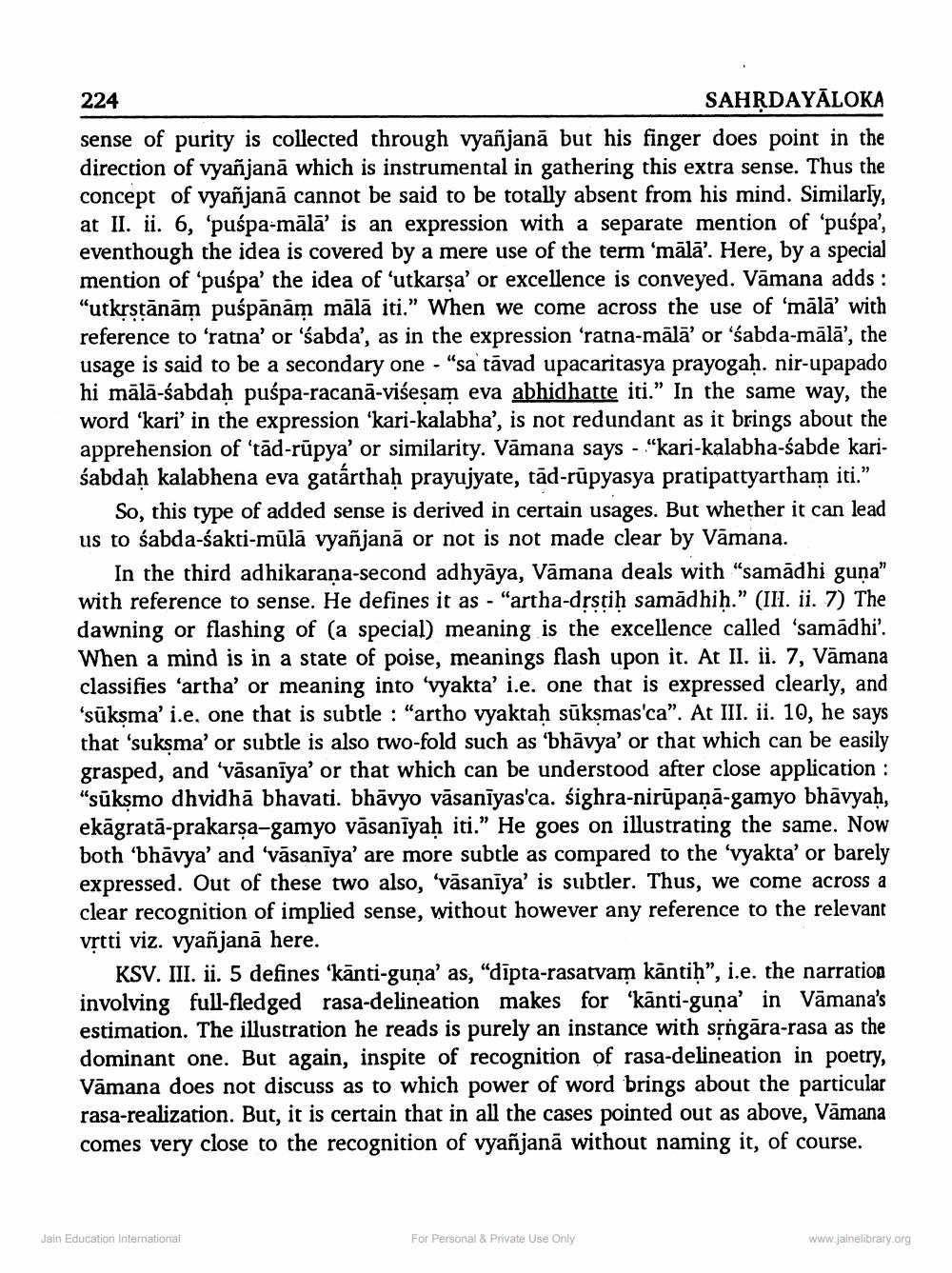________________
224
SAHRDAYĀLOKA sense of purity is collected through vyañjanā but his finger does point in the direction of vyañjanā which is instrumental in gathering this extra sense. Thus the concept of vyañjanā cannot be said to be totally absent from his mind. Similarly, at II. ii. 6, 'puśpa-mālā' is an expression with a separate mention of 'puśpa', eventhough the idea is covered by a mere use of the term 'mālā'. Here, by a special mention of 'puśpa' the idea of 'utkarsa' or excellence is conveyed. Vāmana adds : "utkrstānām puśpānām mālā iti.” When we come across the use of 'mālā' with reference to ‘ratna' or 'śabda', as in the expression ‘ratna-mālā' or 'sabda-mālā', the usage is said to be a secondary one - "sa tävad upacaritasya prayogah. nir-upapado hi mālā-sabdah puspa-racanā-višesam eva abhidhatte iti.” In the same way, the word 'kari' in the expression 'kari-kalabha', is not redundant as it brings about the apprehension of 'tād-rūpya' or similarity. Vāmana says - "kari-kalabha-śabde kariśabdaḥ kalabhena eva gatárthaḥ prayujyate, tād-rūpyasya pratipattyartham iti."
So, this type of added sense is derived in certain usages. But whether it can lead us to śabda-Śakti-mūlā vyañjanā or not is not made clear by Vamana.
In the third adhikarana-second adhyāya, Vāmana deals with “samādhi guna" with reference to sense. He defines it as - "artha-drstih samādhih.” (III. ii. 7) The dawning or flashing of (a special) meaning is the excellence called 'samadhi'. When a mind is in a state of poise, meanings flash upon it. At II. ii. 7, Vamana classifies 'artha' or meaning into 'vyakta' i.e. one that is expressed clearly, and 'sūksma' i.e, one that is subtle : "artho vyaktah sūksmas'ca”. At III. ii. 10, he says that 'sukṣma' or subtle is also two-fold such as 'bhāvya' or that which can be easily grasped, and 'vāsaniya' or that which can be understood after close application : "sūksmo dhvidhā bhavati. bhāvyo vāsaniyas'ca. sighra-nirūpanā-gamyo bhavyah, ekāgratā-prakarsa-gamyo vāsanīyah iti.” He goes on illustrating the same. Now both 'bhavya' and 'vāsaniya' are more subtle as compared to the 'vyakta' or barely expressed. Out of these two also, 'vāsaniya' is subtler. Thus, we come across a clear recognition of implied sense, without however any reference to the relevant vrtti viz. vyañjanā here.
KSV. III. ii. 5 defines "kānti-guna' as, “dīpta-rasatvam kāntih”, i.e. the narration involving full-fledged rasa-delineation makes for ‘kānti-guna' in Vāmana's estimation. The illustration he reads is purely an instance with sộngāra-rasa as the dominant one. But again, inspite of recognition of rasa-delineation in poetry, Vāmana does not discuss as to which power of word brings about the particular rasa-realization. But, it is certain that in all the cases pointed out as above, Vamana comes very close to the recognition of vyañjanā without naming it, of course.
Jain Education International
For Personal & Private Use Only
www.jainelibrary.org




